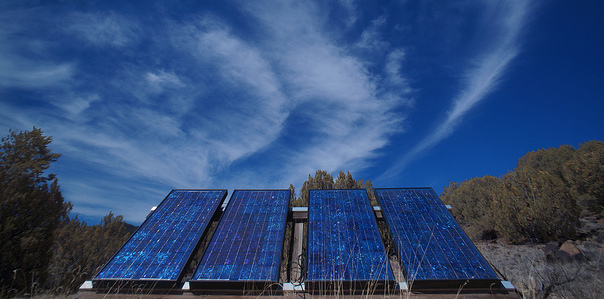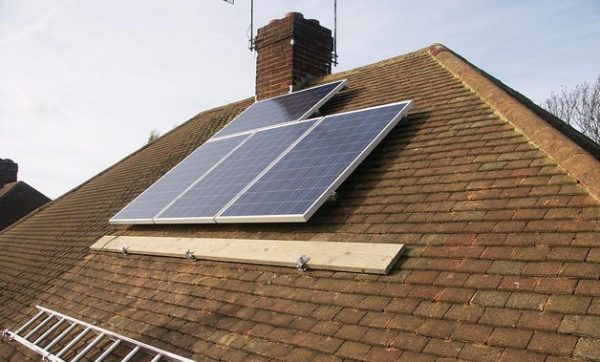Solar Panel Output: How Much Electricity do Solar Panels Produce?

What is standard solar panel output (if there is such a thing)?
This is a great question, but the answer depends on several factors: the amount of sunlight that hits the panel, the size of the panel, and the efficiency of the panel at converting sunlight into electricity.
We’ll cover the details of each factor listed above, but first a little more about solar panel ratings and how to calculate solar output where you live.
Max Power Rating tells you maximum output under ideal conditions

Standards for solar panel output are based on an ideal set of lab conditions, specifically direct sunlight at noon on the equator (‘peak sunlight’ which would be 1000W sunlight / sq. m). You can find the Max Power Rating on the back of any solar panel.
Obviously conditions in real life are never perfect, but we can use this rating as the upper range of what’s possible.
How to calculate solar output for your area
The best way to get hard numbers on solar output where you live is to use a solar calculator. A good one for the technically inclined is Weather Underground’s solar calculator.
Calculators like this one crunch a lot of data, including the intensity of sunlight at your latitude/longitude, the amount of sunlight that can hit a solar panel at that location, and the efficiency of the panels if you have specific information about them.
It’s important to remember that panel output also depends on weather, season, and other factors that vary throughout the year.
How much power does an average solar panel produce?
Cell Count vs Wattage
When we discuss output of the solar panel, we usually use it’s wattage. For residential applications, a typical solar panel is about 260 – 270 watts, meaning that in perfect conditions that solar panel could produce 260 watts of power in a given instant (for reference, an LED light bulb uses about 10 watts).
The number of cells (a solar cell is actually what creates the electricity) in a solar panel determine its size and wattage. Most residential solar panels are composed of 60 solar cells, each producing 5 watts each, and is about 3 feet by 5 feet. Some commercial solar panels have 72 cells, allowing a single panel to produce more electricity, but they are much taller.
However, just because a solar panel has more solar cells and produces more energy doesn’t make it more efficient. When comparing solar panels, also look at the efficiency of the panel – the amount of sunlight that hits the panel which is turned into electricity. Most residential solar panels are about 18% efficient – though they can typically range from 15% to about 18%.
High-efficiency solar panels are more expensive, and are generally only required if you have limited roof space (more efficient panels means smaller panels to produce the same electricity). Keep in mind that high-efficiency does not mean better, so don’t be up-sold on these panels without knowing what the benefits are.
A typical solar installation might be 5 kWh (5 kW produced every hour), which is roughly 25 panels.
Related: An Explanation of kW vs kWh and solar panel kWh.
Nominal Output of your Solar Panels
Solar panels are tested using STC – Standard Test Conditions. STC is, in essence, the perfect situation for the solar panel, in that it would be a bright, sunny, cloudless day with high irradiance levels – ie a lot of strong sunlight.
The wattage printed on the backs of solar panels, referred to as the “nominal wattage” is the output of the solar panel in these perfect conditions. In the real world, it’s possible that the production could be much lower, due to shading or weather.
A lot of homeowners are confused between nominal and real world output. You would think that the wattage printed on the solar panel is what it would produce. That’s certainly possible if your roof had the perfect situation like in the test conditions, but it’s rarely the case. However, having a standard test condition is fairly important. This allows installers and homeowners to compare the efficiency of different solar panels using common testing procedures.
Installation Size
We discussed nominal output for an individual solar panel. Now let’s look at nominal output for a solar installation.
A typical solar installation residential is about 5 kilowatts and is based on the nominal output of the individual solar panels. So, a 5 kilowatt system could be composed of 20 solar panels each at 250 watts a piece.
However, just like a solar panel, you can’t assume your solar system will be working at 100% efficiency at all times. As usual, environmental conditions, especially temperature, play a large role in the efficiency of your system. During test using STC, the temperature of the solar panels is at 25 degrees Celsius (about 76 degrees Fahrenheit) – a fairly low estimate. It’s a fact that as the temperature of a solar panel increases one degree Celsius, it loses about .4% efficiency. So, if a 270 watt solar panel increased from 25 degrees to 45 degrees (113 degrees F, which many in the southwest US see frequently), it would lose about 8% efficiency!
To account for these real world conditions, the National Renewable Energy Lab developed the PVUSA Test Conditions (PTC). PTC mostly accounts for this higher temperature of solar panels in the real world by increasing the temperature of the solar panel to 113 degrees Fahrenheit. Using PTC, a solar panel’s estimated output can be over 10% less than with STC.
Real World System Output
When you decide to move forward with your solar installation, solar companies will account for these “real world” conditions in the quote they provide you during the sales process. The quote will always include the nominal output of the solar installation in kilowatts, but also provide an estimate for how much electricity the system will produce over its lifetime (in kilowatt-hours), using data for typical weather and irradiance levels for the local area.
Solar equipment like inverters and wires are also not 100% efficient. Inverters are typically about 97 or 98% and there’s also ‘line loss’ – electricity lost during transmission through the wires connecting the solar panels to the inverter. Solar companies usually account for these losses in production as well, with what’s known as a ‘derate factor’. The derate factor is just a percentage, usually around 80%, that they multiply your production by which accounts for those losses.
So if you’re a homeowner looking to install solar, you need to discuss with your installer what efficiency losses their estimates take into account. Does it include efficiency loss due to hot summer weather? How about line loss and the inverter’s efficiency? What about dirt on the solar panels?
Now that you know how solar output is calculated, you have the knowledge to be sure that your solar installation will cover as much of your energy use as possible!
So how much electricity does my stuff (electrical gadgets) need?
Great question, and obviously something that depends on your household, but here are some averages:
- Light bulb – 60W
- CFL – 18W
- Laptop – 45W
- Desktop computer – 150-300W
- Window AC – 500-1500W
- Central AC – 1500W
In total, the average US home uses about 903 kWh of electricity per month.
It’s interesting to note that most electricity usage happens at night unless you work from home.
Do I need batteries to store this electricity?
Generally no. These days more residential solar installations are ‘grid-tied’ meaning they have no battery backup systems (which can add tremendous cost to the system). Energy flows from your home into the grid during the day and back out of the grid at night. In many places this means you can get paid for extra electricity you produce. It also means you never have to worry about having enough power because you’re still on the grid.
What about the other factors that affect solar panel output?
Going back to what we mentioned in the beginning, the three factors that affect solar panel output are:
- the amount of sunlight that hits the panel,
- the size of the panel,
- and the efficiency of the panel at converting sunlight into electricity.
Since we’ve covered the size and efficiency of panels, let’s go back to number 1, the amount of sunlight that hits the panel.
What factors affect solar gain, or the amount of sunlight that hits the panel?
 Your geographic location, specifically latitude and longitude, is very important. But even if you’re in a prime solar area a few things affect the amount of sunlight on the panels themselves:
Your geographic location, specifically latitude and longitude, is very important. But even if you’re in a prime solar area a few things affect the amount of sunlight on the panels themselves:
- shading
- debris
- roof tilt
- roof direction
Most solar arrays are installed on your roof, which is essentially unused space. Occasionally ground mounts are used if the roof conditions are not ideal for putting up panels.
Roof direction and tilt are extremely important for total solar output. In the northern hemisphere South facing roofs will get much more sunlight than those facing the North. The angle of the roof also plays into the total amount of sunlight that hits the panels.
Shading is probably the biggest enemy of solar: if trees around your house block sunlight from the roof for large portions of the day it’s likely to take a major chunk out of solar output. Debris from vegetation and other things like snowfall or dust can also obscure the panels and prevent sunlight from entering them.
How does this information help me make a decision about installing solar panels?
The most important take-away here is that calculations for your precise needs can be complex, and it’s hard to give generalized answers to questions about output and panel efficiency.
Like any good question, the answer is: it depends.
Luckily, there are numerous tools to help make things easy. The solar calculator listed above can give you a sense for the numbers, but most homeowners will likely need the estimation of a professional solar installer since final system output also depends on the amount of electricity you need to offset.
More:
Photo credits under CC license:
- https://flic.kr/p/fpZtkr
- https://flic.kr/p/ec15ti
- https://flic.kr/p/aCUtUv
